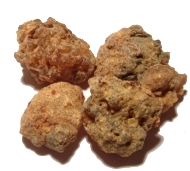Commiphora myrrha
Commiphora myrrha, commonly known as myrrh, is a species of tree in the Burseraceae family, which is native to parts of Africa and the Middle East. Myrrh has been used for thousands of years in traditional medicine, perfumery, and as an incense in religious ceremonies. The tree is particularly known for its resin, which is harvested by making incisions in the bark and allowing the sap to harden into a fragrant gum. This article provides an overview of Commiphora myrrha, including its description, uses, and historical significance.
Description[edit | edit source]
Commiphora myrrha is a small, thorny tree that can grow up to 5 meters in height. It has a knotted trunk, sparse branches, and leaves that are simple or trifoliate, with a pale green color. The flowers are small and can be either red or white. The myrrh resin, which is the most valuable part of the plant, is a natural gum obtained from the dried sap extracted from the stem and branches. The resin is typically a reddish-brown color, though it can vary, and has a distinctive, aromatic fragrance.
Uses[edit | edit source]
Medicinal[edit | edit source]
Historically, myrrh has been used in various cultures for its medicinal properties. It has been utilized as an antiseptic in mouthwashes, gargles, and toothpastes for oral hygiene. Myrrh is also known for its anti-inflammatory and analgesic effects and has been used to treat wounds, ulcers, and arthritis. In traditional Chinese medicine, myrrh is combined with frankincense to enhance blood circulation and treat pain.
Perfumery and Incense[edit | edit source]
In perfumery, myrrh is valued for its warm, earthy, and slightly sweet fragrance. It is used as a fixative, helping to stabilize the scent of perfumes and essential oils. Myrrh has also been historically significant in religious contexts, where it has been used as incense in ceremonies and rituals across various cultures, including in Christianity, Judaism, and Islam.
Cultural Significance[edit | edit source]
Myrrh holds considerable cultural and historical significance, particularly in the religious traditions of the ancient world. It is mentioned in the Bible as one of the gifts brought by the Magi to the newborn Jesus, symbolizing suffering and mortality. In ancient Egypt, myrrh was used in the embalming process and as an offering to the gods.
Cultivation and Harvesting[edit | edit source]
Commiphora myrrha is native to the arid climates of the Arabian Peninsula and the Horn of Africa, including countries such as Yemen, Somalia, Ethiopia, and Eritrea. The tree thrives in dry, desert conditions and requires minimal water. The harvesting of myrrh resin is a labor-intensive process that involves making incisions in the tree's bark and allowing the sap to ooze out and harden. This process can be repeated several times a year without harming the tree.
Conservation[edit | edit source]
The demand for myrrh has led to concerns over the sustainability of Commiphora myrrha populations. Overharvesting and habitat loss are significant threats to the species. Efforts are being made to ensure sustainable harvesting practices and to protect the natural habitats of this valuable plant.
Search WikiMD
Ad.Tired of being Overweight? Try W8MD's physician weight loss program.
Semaglutide (Ozempic / Wegovy and Tirzepatide (Mounjaro / Zepbound) available.
Advertise on WikiMD
|
WikiMD's Wellness Encyclopedia |
| Let Food Be Thy Medicine Medicine Thy Food - Hippocrates |
Translate this page: - East Asian
中文,
日本,
한국어,
South Asian
हिन्दी,
தமிழ்,
తెలుగు,
Urdu,
ಕನ್ನಡ,
Southeast Asian
Indonesian,
Vietnamese,
Thai,
မြန်မာဘာသာ,
বাংলা
European
español,
Deutsch,
français,
Greek,
português do Brasil,
polski,
română,
русский,
Nederlands,
norsk,
svenska,
suomi,
Italian
Middle Eastern & African
عربى,
Turkish,
Persian,
Hebrew,
Afrikaans,
isiZulu,
Kiswahili,
Other
Bulgarian,
Hungarian,
Czech,
Swedish,
മലയാളം,
मराठी,
ਪੰਜਾਬੀ,
ગુજરાતી,
Portuguese,
Ukrainian
Medical Disclaimer: WikiMD is not a substitute for professional medical advice. The information on WikiMD is provided as an information resource only, may be incorrect, outdated or misleading, and is not to be used or relied on for any diagnostic or treatment purposes. Please consult your health care provider before making any healthcare decisions or for guidance about a specific medical condition. WikiMD expressly disclaims responsibility, and shall have no liability, for any damages, loss, injury, or liability whatsoever suffered as a result of your reliance on the information contained in this site. By visiting this site you agree to the foregoing terms and conditions, which may from time to time be changed or supplemented by WikiMD. If you do not agree to the foregoing terms and conditions, you should not enter or use this site. See full disclaimer.
Credits:Most images are courtesy of Wikimedia commons, and templates, categories Wikipedia, licensed under CC BY SA or similar.
Contributors: Prab R. Tumpati, MD


